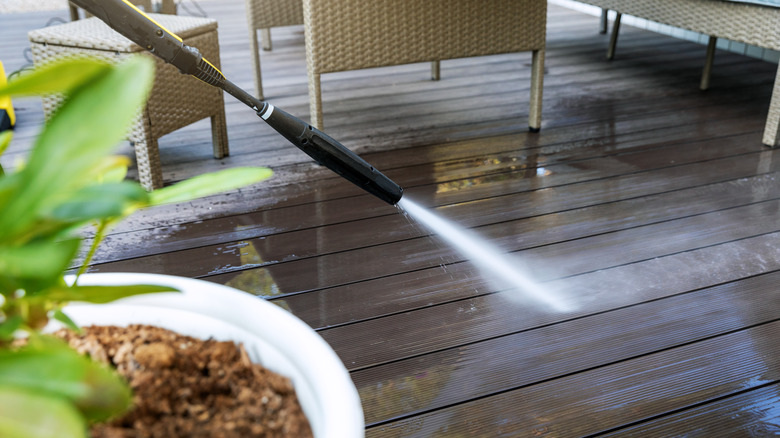

Deck boards warping after rain is a common problem that homeowners face. Dampness and fluctuations in moisture levels can cause the wood to swell and warp, leading to an unsightly and potentially structurally unsound deck. Understanding the causes and implementing preventive measures can save you time, money, and frustration. This article will explore the key reasons for deck board warping after rain, provide practical prevention strategies, and detail effective repair methods. We’ll also discuss choosing the right materials and the importance of proper maintenance. Let’s dive into solutions for a lasting, beautiful deck!
Understanding the Causes of Warping
Moisture Content and Expansion
Wood is a natural material that absorbs and releases moisture. When it rains, deck boards absorb water, causing them to expand. This expansion, coupled with changes in temperature, can lead to warping. The severity of warping depends on factors like the type of wood, the thickness of the boards, and the amount of moisture absorbed. Pressure-treated lumber is less susceptible to warping because of its treatment process. This treatment essentially makes the wood less porous and more resistant to moisture penetration.
Poor Drainage and Inadequate Deck Installation
Poorly designed or constructed decks can also contribute to warping. Standing water around the base of the deck can saturate the wood, leading to significant swelling. Improper drainage can create a moist environment, fostering warping even in seemingly dry conditions. A properly sloped deck prevents water from accumulating around the deck boards.
Seasonal Changes
Seasonal changes in temperature and humidity play a crucial role in deck board warping. Fluctuations in moisture content throughout the year can lead to uneven expansion and contraction of the wood, causing warping. Extreme temperature swings can also stress the wood, further contributing to warping. Choosing materials designed to withstand these fluctuations is critical.
Preventing Warping: Proactive Measures
Selecting the Right Materials
Using pressure-treated lumber for deck boards is highly recommended. This treatment makes the wood less prone to moisture damage. Choosing a material resistant to moisture is a proactive step in preventing warping. Alternatives such as composite decking might be worth considering, as these materials are inherently less prone to moisture issues and therefore less likely to warp over time.
Proper Installation Techniques
Proper installation is key to preventing warping. Ensure adequate space for expansion and contraction, and install the boards with proper spacing. This allows for natural movement without causing stress or damage to the boards. The correct installation method can significantly minimize the potential for future warping.
Regular Maintenance
Regular cleaning and sealing is essential for preventing moisture buildup. Promptly remove debris and standing water, and apply a sealant to prevent moisture from penetrating the wood. Regular maintenance reduces the likelihood of moisture damage, preventing warping.
Repairing Warped Deck Boards
Identifying the Damage
Carefully assess the extent of the warping. Determine whether the warp is minor or if significant structural damage is present. If the warping is severe, it might necessitate replacement. Slight warping might be addressed through a more simple repair.
Repairing Minor Warping
For minor warping, consider using wood filler to fill in gaps and irregularities. A careful sanding and re-sealing process can also help to restore the board’s appearance. Small gaps can sometimes be addressed by simply tightening the screws.
Replacing Damaged Boards
If the warping is significant or if there is structural damage, replacing the damaged boards is the best option. Carefully remove the warped boards and install new ones, ensuring proper installation techniques are followed. This is a more significant process and likely needs professional help. It’s also important to ensure the boards are the appropriate size and spacing for your deck.
Additional Considerations for Preventing Warping
Effective Drainage Systems
Ensure proper drainage around the deck area to prevent water from pooling. Install downspouts, gutters, and consider grading to direct water away from the deck. Efficient drainage systems are crucial for preventing water damage and warping.
Regular Inspections
Schedule regular inspections of your deck, especially after periods of heavy rain. Check for any signs of warping, damage, or moisture issues. Regular inspection helps identify and address problems early on, reducing the need for extensive repairs.
Deck Sealant Application
Regular sealant application can form a barrier, creating a shield against moisture. Applying sealant to your deck prevents moisture penetration and the likelihood of moisture-related problems like warping. Regular sealing helps in protecting the deck against potential damage.
Case Study: Successful Warping Prevention
A homeowner in Seattle installed a composite decking system for their deck. They also improved the drainage around their deck. Within five years, they experienced no warping issues. This highlights the efficacy of choosing the right materials and designing for effective moisture management.
Choosing the right materials
Pressure-Treated Lumber
Pressure-treated lumber is a popular choice for its durability and resistance to rot and insect infestation. However, it’s still susceptible to warping due to moisture. Its resistance to moisture is important to consider when choosing this material, as it will be less likely to warp compared to standard lumber.
Composite Decking
Composite decking is another option that’s highly resistant to moisture. Composite materials are less porous and less prone to absorbing moisture compared to wood. Thus, this option is better for preventing warping compared to standard wood decking.
Specific Wood Types
Different wood types have varying degrees of resistance to moisture. Some woods, like cedar, are naturally more resistant to warping than others. Knowing the properties of different wood types is an important step to selecting the right material.
Maintenance Tips to Enhance Deck Life
Cleaning
Regular cleaning removes dirt, debris, and other accumulated material, which can obstruct proper moisture flow. This maintenance prevents the buildup of moisture and debris around the deck boards, reducing the risk of warping.
Inspection
Checking your deck periodically helps you identify any issues, including warping, early on. This proactive approach allows you to address potential problems quickly and prevents significant damage.
Sealant Application
Applying sealant regularly provides a protective layer against moisture, preventing it from penetrating the wood. This simple step can substantially extend the life of your deck and reduce the occurrence of warping.
In conclusion, preventing deck boards from warping after rain requires a multifaceted approach. Proper maintenance, including regular cleaning and sealing, is crucial for longevity. Choosing the right materials, like pressure-treated lumber, is also a key factor. Addressing underlying issues like drainage problems can also prevent future warping. By taking proactive steps to maintain your deck boards, you can ensure they remain structurally sound and aesthetically pleasing for years to come. For further guidance on specific deck board maintenance or repair needs, contact a local deck expert or visit our website for additional resources.